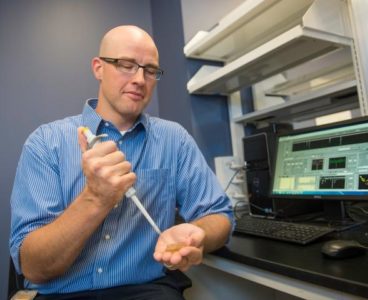
Light-Up Nanoparticle Hunts Down, Treats Breast Tumors
One major problem in treating cancer is identifying the location of small tumors and treating them before they metastasize. In an effort to overcome that problem, researchers at Wake Forest Baptist Medical Center have developed a fluorescing nanoparticle capable of finding tumors, lighting up upon arrival and being activated with light to generate heat to…
Nanotechnology Detects Molecular Biomarker for Osteoarthritis
For the first time, scientists at Wake Forest Baptist Medical Center have been able to measure a specific molecule indicative of osteoarthritis and a number of other inflammatory diseases using a newly developed technology. This preclinical study used a solid-state nanopore sensor as a tool for the analysis of hyaluronic acid (HA). HA is a…
Scientists use Nanotechnology to Detect Molecular Biomarker for Osteoarthritis
For the first time, scientists at Wake Forest Baptist Medical Center have been able to measure a specific molecule indicative of osteoarthritis and a number of other inflammatory diseases using a newly developed technology. This preclinical study used a solid-state nanopore sensor as a tool for the analysis of hyaluronic acid (HA). HA is a…
Computational Body Models: The New Generation of Crash Test Dummies
Think of them as digital dummies. Or crash test avatars. They’re computational human body models, anatomically accurate computer figures built from MRI, CT and other medical scanning techniques to simulate how the body’s bones, organs and connective tissues react to external objects and forces. Over the past decade, these virtual manikins have become valuable tools…



